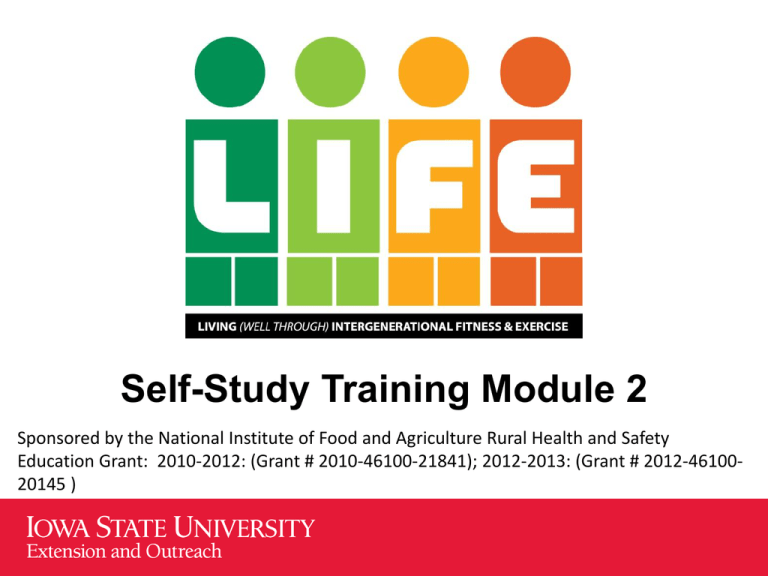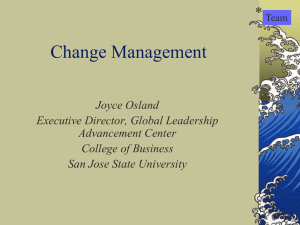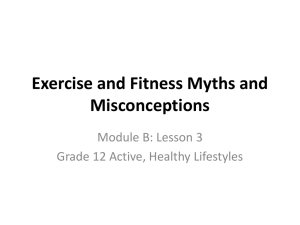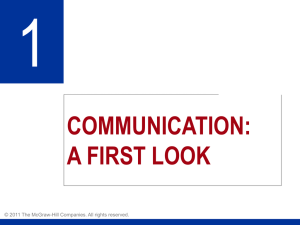Module 2: Older Adults - Iowa State University Extension and Outreach
advertisement

Self-Study Training Module 2 Sponsored by the National Institute of Food and Agriculture Rural Health and Safety Education Grant: 2010-2012: (Grant # 2010-46100-21841); 2012-2013: (Grant # 2012-4610020145 ) DEVELOPED BY: Sarah L. Francis PhD, MHS, RD Assistant Professor/State Nutrition Extension and Outreach Specialist Department of Food Science and Human Nutrition Jennifer Margrett, PhD Associate Professor Department of Human Development and Family Studies Warren D. Franke, PhD Professor Director, The Exercise Clinic at ISU Department of Kinesiology Iowa State University Ames, IA 2012 OLDER ADULT OVERVIEW • Demographics • Misconceptions • Aging Myths • Older Adults as Learners Demographics The older adult population in the United States is growing and diversifying! What Comes to Mind? • Senior citizens • Old people • Aging • Older Adults • Elderly Misconceptions about Older Adults • Frail • Dependent on others • Forgetful • Grouchy • Senile • Sick • Poor health • Unknowing • Lonely • Unintelligent Ageism • Makes it difficult to see older adults as they actually are • Isolates the older generation socially • Spreads the fear of aging Let’s see how accurately you know the older adult population: MYTH or REALITY? MYTH or REALITY? Most older adults are alone and lonely MYTH • Number of close friends throughout a person’s life stays the same • Reported feelings of loneliness less often than young adults MYTH or REALITY? Most older adults are in poor health MYTH • Over 2/3 of those 65+ said they were in good, very good, or excellent health • 80% of those 85+ carry out all daily activities MYTH or REALITY? Older adults tend to have a slower reaction time than those who are younger. REALITY • As we age, the speed of our reflexes and movements decrease MYTH or REALITY? Older adults are less productive than younger workers MYTH • Older adults are: o o o o Highly motivated Flexible with work schedules Reliable & have low rates of absenteeism Excellent mentors for younger workers MYTH or REALITY? Most older adults have no interest in or capacity for intimate relations MYTH • Good health, not age, is the key to intimate relationships throughout life MYTH or REALITY? Most older adults end up in nursing homes MYTH • Only about 5% of older adults live in a nursing home • 3 out of 4 Americans will never reside in a nursing home MYTH or REALITY? All five senses tend to decline with aging REALITY • By late adulthood, vision and hearing are almost always impaired. o 9 out of 10 older adults need glasses o 1 out of 3 would benefit from a hearing aid MYTH or REALITY? Physical strength tends to decline in old age REALITY • Physical strength declines • The lung vital capacity declines Exercise can counteract and limit the amount of loss in strength MYTH or REALITY? The majority of older adults feel miserable much of the time MYTH • The majority report high levels of life satisfaction MYTH or REALITY? In general, most older adults are pretty much alike MYTH • Older adults are more diverse than younger adults in: o Life-style o Income o Personality MYTH or REALITY? The majority of older adults have incomes below the poverty level MYTH • 1 in 10 older adults live in poverty • The poverty rate among older adults age 65+ is lower than those under 65 years MYTH or REALITY? The majority of older adults are working or would like to have some kind of work to do REALITY • 1 out of 3 individuals over the age of 75 are involved in volunteer activities • Most older adults say they are seldom bored MYTH or REALITY? Older adults are stubborn, set in their ways and don’t like to try new things. MYTH • Over 80% of older consumers are receptive to new products and services MYTH or REALITY? Older adults avoid new technologies MYTH • In 1998, over 25% of computers were purchased by older adults • Older adults spend more time on the Internet than 12-17 year olds MYTH or REALITY? Playing bingo and cards are the number one and two recreational activities for seniors MYTH • 27% of older adults attend movies, sports events, clubs, and group events MYTH or REALITY? Older adults learn new things at a slower speed than younger generations REALITY • Thinking processes slow with age • Limited eye sight and hearing loss can decrease the amount of “information” that travels to the brain. MYTH or REALITY? When you turn 65, you become a senior citizen MYTH • The least important way individuals age is by chronological age MYTH or REALITY? Physical handicaps are the primary factors limiting the activities of older adults MYTH • 75% say they are healthy enough to carry out their normal daily activities independently MYTH or REALITY? Older generations tend to be more religious than younger generations REALITY • People generally keep the same level of religious belief throughout their lives, but there is a trend of religiosity being greater in the older generation than in younger generations MYTH or REALITY? Pain is a natural part of the aging process MYTH “A man goes to the doctor complaining of pain in his right knee. The doctor says to him, “You have to expect this. You are getting older". To which the man replies, "My other knee is just as old and it doesn't hurt." MYTH or REALITY? The majority of older adults say they feel irritated or angry most of the time MYTH • Older adults are no more angry or happy than younger adults Older Adults… • Do not become “more” of anything as they age • Are just as capable as anyone else in completing most activities • Are happy with their life • Stay active and busy The strongest predictor of high lifesatisfaction in later life is the perception that one’s life is purposeful and has a positive evaluation of one’s mental and physical health. Older Adults • Diet, exercise, substance-free habits, and a sense of purpose can: – Slow the effects of aging – Prolong vitality – Prevent or postpone disability Older Adults as Learners • Older adults spend more than 300 hours each year in learning endeavors Older Adults as Learners • • • • • • Big picture Need for community Goal-oriented Practical Independent “Hands-on” approach Older Adults as Learners • Physical limitations • Slower pace • Gain competence and mastery • Results-oriented Building Relationships • Show respect • Take into consideration any physical limitations, but do not overlook what they are still capable of doing • Interact with older adults continuously to grow more comfortable with them • Quality of time spent together rather than quantity of time Building Relationships • Be engaged during time together • Stay interested in the activity or conversation • Show concern and empathy when needed • Treat them as a friend, not as an older adult Working with Older Adults • Be safe, sensitive, & alert to individual needs • Dress appropriately • Be kind and understanding • Be aware of age-related sensory changes “The oldest trees often bear the sweetest fruit.” For more information… • Read Chapter 3 in the LIFE Program manual Preparing for Training Workshop • Complete all self-study modules • Read the entire LIFE Program manual • Wear loose fitting comfortable clothing. You will be taking part in the exergaming and interactive game activities. Sources • Carnaham, R. and Parker, S. (2002). Serving seniors: a resource manual for Missouri libraries. MO: Missouri State Library. • Centers for Disease Control and Prevention. National Center for Health Statistics. Health data interactive. www.cdc.gov/nchs/hdi.htm. [November 19, 2010]. • Harris, D.K., Changas, P.S., and Palmore, E.B. (1996). Palmore’s first Facts on Aging Quiz in a multiple-choice format. Educational Gerontology, 22(6): 575589.) • Hiemstra, E. (1980). Guiding the older adult learner. Education Resources Information Center. • Lingren, H. (1991). Myths and facts about aging. University of Hawaii at Manoa Cooperative Extension Service. • U.S. Department of Health and Human Services Administration on Aging (2009). A profile of older Americans: 2009. • Wilken, C. S. (2008). Myths and realities of aging. University of Florida IFAS Extension.








